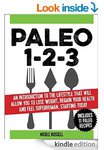Free for a limited time, this quick to read book will give you everything you need to know to get started on the Paleo lifestyle, today. Includes 10+ recipes to get you started, as well as tips, tricks, and of course, the rules. Usually $3.99
$0 Free eBook on The Paleo Diet - Paleo 1-2-3 Usually $3.99
Last edited 17/10/2014 - 15:27 by 1 other user
Related Stores
closed Comments

Tells me Not available for purchase

Thanks steptoe, you're a wizard

Thanks Steptoe, I didn't think of that :)

Many of the ingredients aren't Paleo foods; as they come from the Americas and we haven' been exposed to them during our evolution for 10's of thousands of years (the whole premise of the Paleo diet).
Capsicum (all peppers) is a genus of flowering plants in the nightshade family Solanaceae. Its species are native to the Americas.
The tomato is the edible, often red fruit/berry of the nightshade Solanum lycopersicum. The species originated in the South American Andes.Anatomically modern humans didn't get to the Americas before about 13,000 years ago and this certainly won't affect Caucasian evolution. It probably isn't even long enough to adopt dietary change for native Americans, as strong sustained dietary influences are required to be in place for about at least 10,000 (but more like 40,000) years for the population to adapt to them. This is why Paleo dieters avoid anything introduced to the diet less than (at least) 10,000 years ago.
From a quick look, at least the following ingredients should be removed to consider the recipes closer to Paleo: cheese, potato, peppers, tomato, butter, soy sauce, tomato paste.
Processed foods such as olive oil and coconut sugar are also very questionable.

Hi cheapsk8, thanks for pointing that out. There are many foods that fall into gray areas when practicing Paleo, depending on how hard core you want to go. While some of those foods are not strictly Paleo, this point is addressed in the book; as is the 80/ 20 rule, to allow people to make their own choices. There is actually a whole section about potatoes and another about dairy :)

Mark Sisson of the Primal Blueprint promotes this idea, with a 80% Paleo interpretation that he says should be followed 80% of the time. I guess that's fine if you are happy to consume more than a third of your diet as non-Paleo ingredients and still think you are on-board. It's a bit of a stretch to call a recipe Paleo though if ingredients obviously aren't.
Your book is no worse than any of the multitude that are out, but I'd really like to see someone do it properly.

Properly is subjective when it comes to paleo diets
http://m.huffpost.com/us/entry/1898529A few choice comments
- not backed by scientific evidence
- some excluded foods can lead to Health issues such as osteoporosis (re: milk)Like all silver bullets, do your research carefully. There are many foods that would be excluded on a strict Paleo diet (eg. Apples and oranges - not widely grown or available until far more recent times).
Ill skip the paleo diet for my family, but YMMV.

There is plenty of scientific evidence for those that care to look. Here's the first hit from a lazy Google search:
http://authoritynutrition.com/5-studies-on-the-paleo-dietNo animal requires milk past weaning to build and maintain strong bones.
Also bones aren't just made out of calcium and consuming more milk will upset your calcium/magnesium/zinc balance and can be detrimental to bone health.

Perhaps you have found a market for yourself ;)
Thanks for your comments cheapsk8, all feedback is welcome.

Does this book include insects ? Can't be true paleo without insects as ingredients. BTW, caveman's life expectancy was about 25-30 years, just to let you know.

High infant mortality rates account for a low average. The average 'caveman' made it past teen years lived longer than those that started farming (until improvements in medicine stopped the diseases).

Perhaps high infant mortality rate was due to cavewoman on caveman's diet ? Just a thought.

Yeah they made it through 4 million years by eating food that caused them to die at birth.

Perhaps cavewomen didn't have enough nutrients hence high infant mortality rate, and yes they survive 4 millions years by eating more carb otherwise we would still be cavepeople and maybe not that many of us.

Hi z28,
Although not overtly expressed, insects are in fact optional in all of the recipes. If you follow the written instructions, then leave the recipe on the bench, or preferably outside, insects will in get themselves involved and form part of your Paleo diet :)
A caveman's life expectancy was reliant on a number of environmental factors, such as being stressed out because they hadn't eaten in days or had just been chased by a saber toothed tiger, for example.
I'm not sure if you actually read the book, however it is written in such a way that the paleo lifestyle is presented so as to give an interested party all the necessary information they need to make an informed decision about whether or not it is right for them, it is not presented as the be and and end all of lifestyle choices.
Hope that helps :)
Not reduced now . However perhaps I should read this as it may help
http://www.amazon.com/gp/product/B00L5YPNBG thanks to TA.

Hotspoting repeated comment sorry



Publisher: Zen Publishing (October 7, 2014)